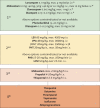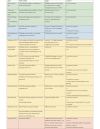The three pillars in treating antibody-mediated encephalitis
- PMID: 37278857
- PMCID: PMC10776469
- DOI: 10.1007/s00508-023-02214-3
The three pillars in treating antibody-mediated encephalitis
Abstract
The rapid initiation of immunotherapy has a decisive impact on the course of the disease in patients with antibody-mediated encephalitis (AE). The importance of treating AE with antiseizure medication and antipsychotics is discussed controversially; however, standardized procedures should be ensured, especially for the initiation of treatment in severe disease. Recommendations and guidelines for further interventions in refractory courses are needed. In this review, we contrast the three mainstays of treatment options in patients with AE and attempt to highlight the importance of 1) antiseizure therapy, 2) antipsychotic therapy, and 3) immunotherapy/tumor resection from today's perspective.
Keywords: Antineuronal antibodies; Antipsychotics; Autoimmune encephalitis; Epilepsy; Immunotherapy.
© 2023. The Author(s).
Conflict of interest statement
S. Macher has nothing to disclose with respect to this manuscript, G. Bsteh has participated in meetings sponsored by, received speaker honoraria or travel funding from Biogen, Celgene, Merck, Novartis, Sanofi-Genzyme and Teva, and received honoraria for consulting Biogen, Roche and Teva. E. Pataraia has nothing to disclose with respect to this manuscript, T. Berger has participated in meetings sponsored by and received honoraria (lectures, advisory boards, consultations) from Almirall, Bayer, Biogen, Biologix, Bionorica, Celgene/BMS, GSK, MedDay, Merck, Novartis, Octapharma, Roche, Sandoz, Sanofi-Genzyme, Teva and TG Pharmaceuticals. His institution has received financial support in the past 12 months by unrestricted research grants (Biogen, Celgene/BMS, Merck, Novartis, Sanofi-Genzyme, Teva) and for participation in clinical trials in multiple sclerosis sponsored by Alexion, Biogen, Celgene/BMS, Merck, Novartis, Roche, Sanofi-Genzyme and Teva. P.S. Rommer has received honoraria for consultancy/speaking from AbbVie, Alexion, Almirall, Biogen, Merck, Novartis, Roche, Sandoz, Sanofi-Genzyme and has received research grants from Amicus, Biogen, Merck and Roche. R. Höftberger has received speaker honoraria from Novartis and Biogen.
Figures


Similar articles
-
Autoimmune encephalitis: novel therapeutic targets at the preclinical level.Expert Opin Ther Targets. 2021 Jan;25(1):37-47. doi: 10.1080/14728222.2021.1856370. Epub 2020 Dec 31. Expert Opin Ther Targets. 2021. PMID: 33233983 Review.
-
Glutamate receptor antibodies in neurological diseases: anti-AMPA-GluR3 antibodies, anti-NMDA-NR1 antibodies, anti-NMDA-NR2A/B antibodies, anti-mGluR1 antibodies or anti-mGluR5 antibodies are present in subpopulations of patients with either: epilepsy, encephalitis, cerebellar ataxia, systemic lupus erythematosus (SLE) and neuropsychiatric SLE, Sjogren's syndrome, schizophrenia, mania or stroke. These autoimmune anti-glutamate receptor antibodies can bind neurons in few brain regions, activate glutamate receptors, decrease glutamate receptor's expression, impair glutamate-induced signaling and function, activate blood brain barrier endothelial cells, kill neurons, damage the brain, induce behavioral/psychiatric/cognitive abnormalities and ataxia in animal models, and can be removed or silenced in some patients by immunotherapy.J Neural Transm (Vienna). 2014 Aug;121(8):1029-75. doi: 10.1007/s00702-014-1193-3. Epub 2014 Aug 1. J Neural Transm (Vienna). 2014. PMID: 25081016 Review.
-
[An Update on Therapeutic Management in Autoimmune Encephalitis].Brain Nerve. 2023 May;75(5):479-484. doi: 10.11477/mf.1416202362. Brain Nerve. 2023. PMID: 37194516 Review. Japanese.
-
The therapeutic effect of ofatumumab in autoimmune encephalitis: A case series.J Neuroimmunol. 2023 Apr 15;377:578062. doi: 10.1016/j.jneuroim.2023.578062. Epub 2023 Mar 6. J Neuroimmunol. 2023. PMID: 36898305
-
Clinical efficacy of plasma exchange in patients with autoimmune encephalitis.Ann Clin Transl Neurol. 2021 Apr;8(4):763-773. doi: 10.1002/acn3.51313. Epub 2021 Feb 20. Ann Clin Transl Neurol. 2021. PMID: 33609012 Free PMC article.
Cited by
-
Intravenous Methylprednisolone in Guillain-Barré Syndrome: The Way Forward.Ann Indian Acad Neurol. 2025 Mar 1;28(2):180-181. doi: 10.4103/aian.aian_113_25. Epub 2025 Apr 11. Ann Indian Acad Neurol. 2025. PMID: 40215101 Free PMC article. No abstract available.
References
Publication types
MeSH terms
LinkOut - more resources
Full Text Sources

